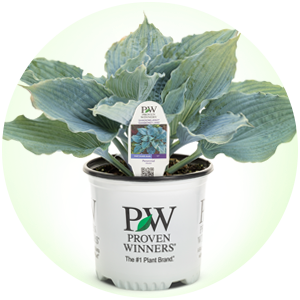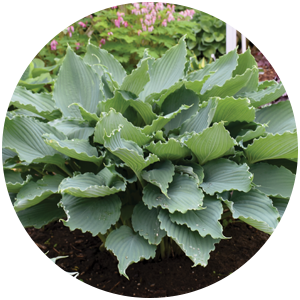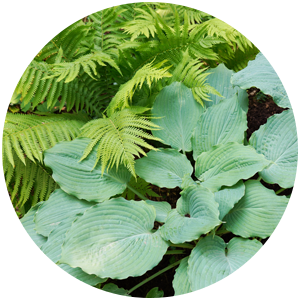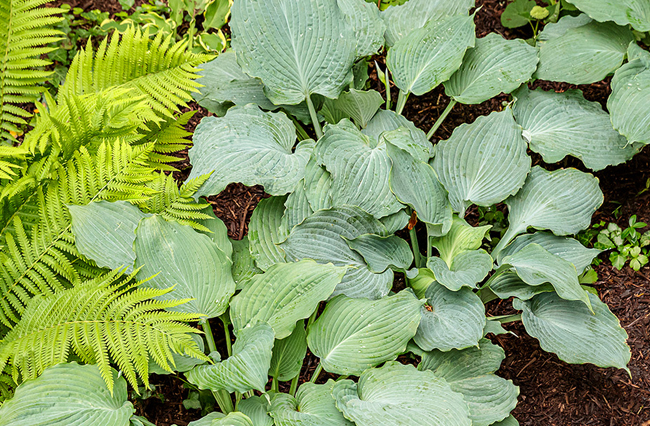SHADOWLAND® ‘Diamond Lake’
Hosta
A Diamond in the Shade
- Large, striking foliage plant for shade gardens
- Heart-shaped leaves with distinctly rippled edges and thick texture
- Powder blue color glows in the evening light
- Grows beautifully in containers and landscapes
- Light lavender flowers appear in early summer
- 17” tall x 45” spread
- Perennial in USDA Zones 3-9
- Pronounced “HAH-stuh”
Shade gardening can be just as thrilling as gardening in the sun if you pick the right plants. ‘Diamond Lake’ is one of those hostas that you’re sure to fall in love with once you give it a try. We find it absolutely enchanting as it lights up in the early evening light, much like white flowers tend to do in moon gardens. Planting it in full shade to dappled sun helps it retain the blue waxy coating on its leaves which gives it that ethereal glow.
A large, stately shape and heart-shaped, distinctly rippled leaves ensure this hosta won’t fade into the background of your landscape. Try using it as a focal point surrounded by low growing Double Up® begonias or pair it with ‘Crested Surf’ painted ferns for superb textural contrast.
Hostas are perennials that you’ll come to appreciate more with each passing year as they build their character. The leaves of ‘Diamond Lake’ thicken up and become more intensely rippled and corrugated as they age. The clump becomes fuller as more eyes develop at the base and within a few years, it’s ready to be divided. Try growing it in the dappled shade of tall trees or in the shadow of your home’s eaves.
HOW TO GROW SHADOWLAND® ‘DIAMOND LAKE’ HOSTA

Planting
When choosing a spot to plant ‘Diamond Lake’ hosta, consider that it prefers to grow in morning sun or dappled sun throughout the day. Afternoon sun can be too strong and burn the foliage, especially in warm climates.
The first place you might consider planting your new hosta is under a tree. If the tree is deeply rooted, like an oak or hickory, there will be plenty of room for the hosta’s roots to grow. But maples, birches and spruce trees have broad, shallow root systems that could outcompete the hosta for root space. Consider root competition when finding the right spot.
‘Diamond Lake’ hosta grows best in humus-rich soil that is moist and well-drained, but it will also grow reasonably well in sandy and clay soils. Use a good quality potting soil with a bit of slow release plant food mixed in if you plan to grow it in a container.
This hardy perennial isn’t too fussy about when you plant it. Cooler spring and fall weather is ideal, but if summer is your only option, just be sure to plant it in the shade and keep the soil moist through the warmest months while its roots get established.
When planting, dig the hole about twice as wide but just as deep as the container it is growing in. If your soil is light in color–indicating it doesn’t contain much organic matter–add several handfuls of humus, compost or aged manure when you backfill the hole. That will provide extra nutrients and water-holding capacity to the soil.

Maintenance
Hostas require very little maintenance during the growing season. They need little more than some shade, good soil and moisture to flourish all on their own.
Watch for rabbits in spring–this is their favorite time of year to munch on hostas. Just as their pointed tips emerge from the soil, a hungry bunny may come along and nip them off. It won’t hurt the hosta but once its leaves unfurl, you’ll see the bunny’s teeth marks. Avoid this by applying animal repellent on your hostas in early spring just as they start to come up.
If deer are an issue in your garden, consider growing more deer resistant plants or plan to protect your hostas with animal repellent or fencing. Taller, thinner leaved cultivars are more prone to damage simply because they are easier for the deer to eat.
During wet weather, slug populations can multiply quickly. If you start seeing holes in your hosta leaves, it’s a sure sign that they have moved in. Here is an article to help you “slug it out” with these pesky creatures.
Hostas should be cut back in fall once their foliage has gone to sleep for the season. Remove the spent foliage from the garden bed and dispose of it to help avoid future slug damage around the plants.

Companion plants
When pairing your hostas with other plants, look for those that prefer similar cultural conditions, including a preference for partial to full shade and rich, moist soil. Your local garden center likely has a separate section for shade perennials where you’ll find all sorts of companions for ‘Diamond Lake’.
Pictured here, Dolce® ‘Wildberry’ coral bells complement ‘Diamond Lake’ hosta in part shade. What makes this a perfect pairing? The plants share the same preferences for shade and moisture, the contrast in leaf sizes creates definition in the pairing, and both lie on the cool end of the color spectrum shining in blue and purple with silvery accents.
If you’re looking for flowering plants to pair with ‘Diamond Lake’ and like the idea of a cool color palette, try ‘Queen of Hearts’ Brunnera which blooms with baby blue flowers in the spring or ‘Heaven Scent’ Jacob’s ladder which also bears blue flowers but with the bonus of adding beautiful textural contrast with its fernlike foliage. Then, bring in warm pink blooms beginning in late summer with Fall in Love™ ‘Sweetly’ Japanese anemones. You’re going to have the most beautiful shade garden in the neighborhood when you’re finished!
top 3 reasons to
grow ‘Diamond Lake’ Hosta
THIS IS ONE DIAMOND OF A HOSTA
Of the oodles of hostas you could grow, ‘Diamond Lake’ will be one of the most distinctive. You’ll easily spot it from quite a distance as it shines as a focal point.
IT WILL THRIVE IN YOUR SHADIEST PLACES
While many showy perennials need full sun to thrive, ‘Diamond Lake’ will happily light up your shade garden with its ethereal blue foliage.
IT’S SUPER COLD HARDY
Hardy down to -40°F, you will never have to worry about it returning reliably every year.

Shadowland® ‘Diamond Lake’ Hosta USPPAF 30,769, Can PBRAF

